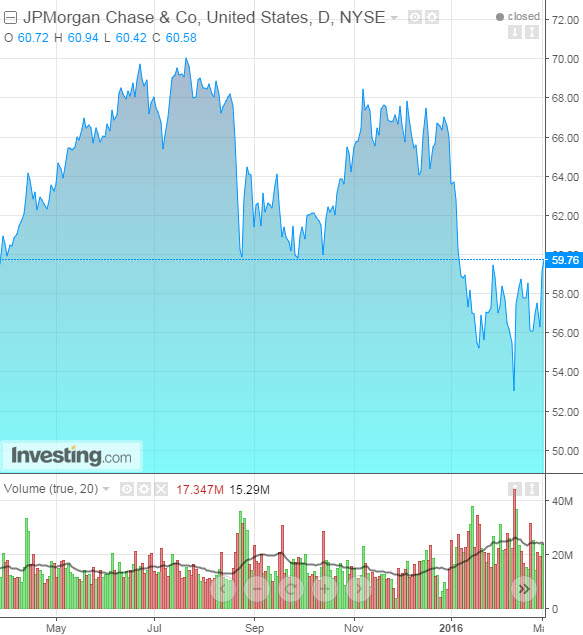by Clement Thibault
These are rough times for the financial sector. Of course, things have been tough for financials since the 2008 market crash.
But today’s situation seems perhaps a bit worse: High volatility, general uncertainty concerning future interest rate hikes, fears of looming recession and anxiety over oil-related loans are the main reasons for financials’ current troubles. The aforementioned reasons damaged not only the profits of major banks, but also the value of their stock and market capitalization.
Indeed, this past Tuesday, Barclays (NYSE:BCS) cut its dividend payment by more than 50%, a result of previously announced losses of $548.3 million for 2015, compared to $243.4 the year before. According to the Wall St. Journal:
The {bank’s} chief executive said shareholders, who have seen the value of their investment shrivel nearly 40% over the past year, were ‘tired’ with the time it was taking to fix the bank.
Barclays isn’t an isolated case either, though it may currently be the most prominent. According to Trinity Asset Management founder Brian Gilmartin, quoting from Reuters' data, “Financial sector earnings are now expected to be negative for Q1 and Q2 ’16.”
With Financials making up nearly 20% of the S&P 500 by market cap, should you assume the entire index will be dragged down by the major banks? Or are there some hopeful signs emerging from the financial melt-down?
Year-to-Date, Wells Fargo (NYSE:WFC) has been the best performer among major banks - it lost "only" 13.6% since January 4th. JPMorgan Chase (NYSE:JPM) didn't do much worse, dropping ‘just’ 14.7%. With prices down – is this actually a buying opportunity?
JPMorgan's CEO Jamie Dimon surely thinks so. Dimon recently put $26 million of his own money into company shares at an average price of $53.18. This purchase is considered unusual, as most stock owned by top executives comes from company grants or heavily discounted options.
Similarly, there’s a well known buyer snapping up Wells Fargo shares too. But, instead of the bank’s CEO, it’s Warren Buffet and Berkshire Hathaway (NYSE:BRKa) that were the buyers. According to Berkshire Hathaway's most recent filing with the SEC, the multi-national conglomerate purchased about 9 million shares of the San Francisco-based bank in the last quarter, adding to its already massive $23B position—its second biggest holding after the $25B stake it owns in Kraft Heinz (NASDAQ:KHC).
This of course shouldn’t be taken as a signal that these two banks are primed for a quick stock price recovery. Both are exposed to the energy sector, and still have to deal with losses incurred by low oil prices.
Last week, JPMorgan announced it would put $500 million aside for losses related to oil and gas investments, on top of the $815 million it has already set aside by the end of 2015. Further, Dimon acknowledged the possible need to build more reserves, as much as $1.5 billion more, should oil hit $25 and stay there for 18 months. Wells Fargo on the other hand has dedicated $1.2B in reserves for potential oil and gas losses, although the sector represents only 2 percent of the bank's loan portfolio.
While these numbers may seem large, remember that JPMorgan has about $2.4 Trillion in assets, and posted a net profit of $4.9 billion in a very problematic 2015 Q4. Sure, that $4.9B profit was down about 10% from Q4 2014's $5.4B, but annually, including the drop in Q4 profitability, JPMorgan's net income was up by $2.4B, or 12%, from $20B to $22.4B.

Meanwhile, Wells Fargo’s Q4 2015 earnings surpassed analysts' expectations and posted year-over-year growth, with an EPS of 1.03 against expectations and last year's number of 1.02. The company is still a leader in the mortgage market, as well as the second largest student loan organization in the US—two key areas for growth in the coming year.

While earnings and revenues are bound to be hurt yet more during 2016, expectations call for a better, more profitable 2017. JPM's EPS in 2015 was $6; That's expected to fall to $5.78 in 2016, but forecasts call for it to bounce back to $6.41 in 2017. Similarly, WFC's EPS in 2015 was $4.12; That's expected to tick up a notch to $4.29 in 2015, with further upside arriving in 2017 forecasts which are estimating an EPS of $4.60 per share for the bank.
In short, these losses don't appear to be anything these global banks can't handle. Overall, both appear to be performing the way any healthy company would when it hits a rough patch. Bottom line: each is still in a strong position going forward.
The thing to remember about financial stocks is that often, they mirror investors’ trust in the economy's growth, both domestic and global. Therefore, financial stock prices are not only hurt because of the objective losses from investments and exposures, but also by public sentiment.
It would seem that the intrinsic value of these two banks has not fallen as low as their stock price would suggest. We see that as creating a good buying opportunity for long-term and value investors.
